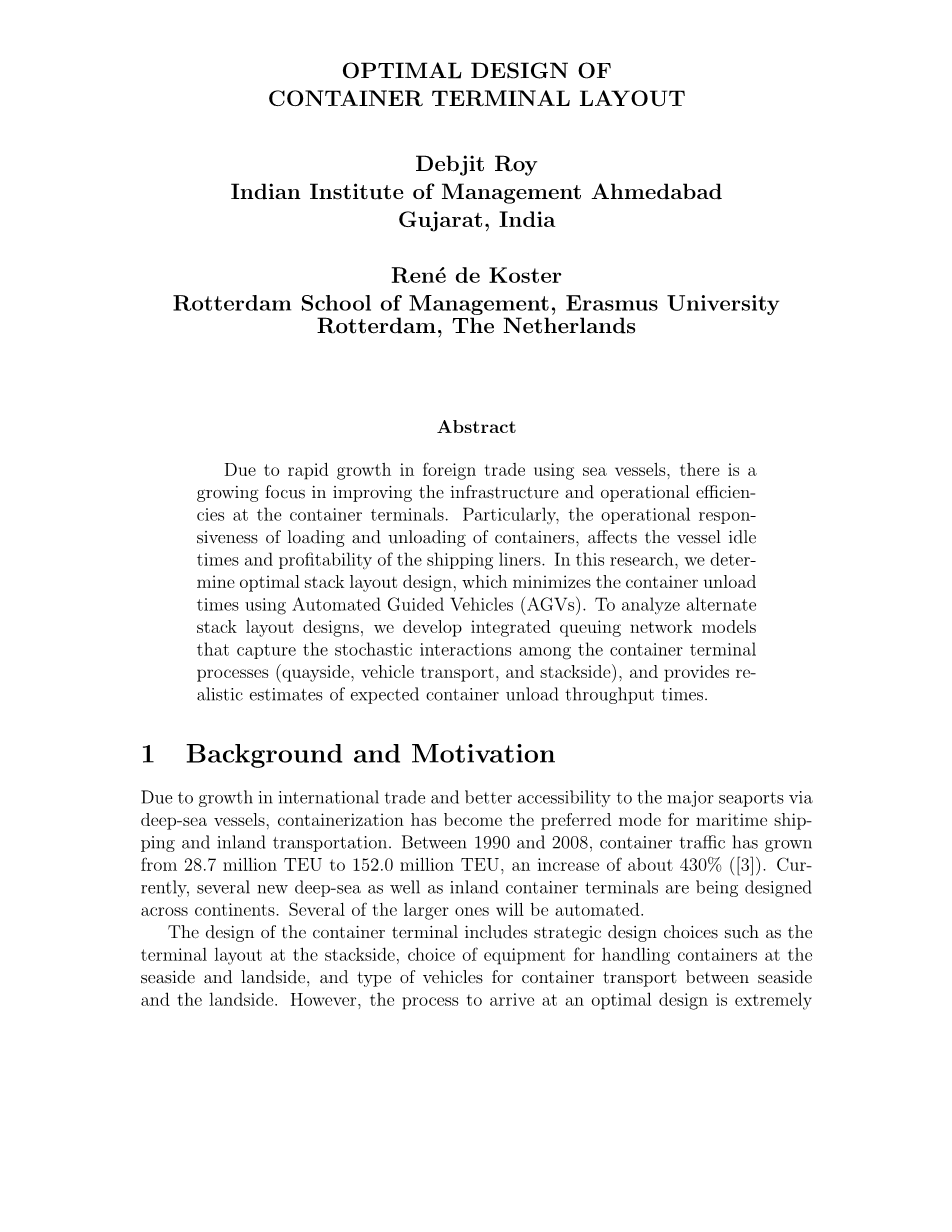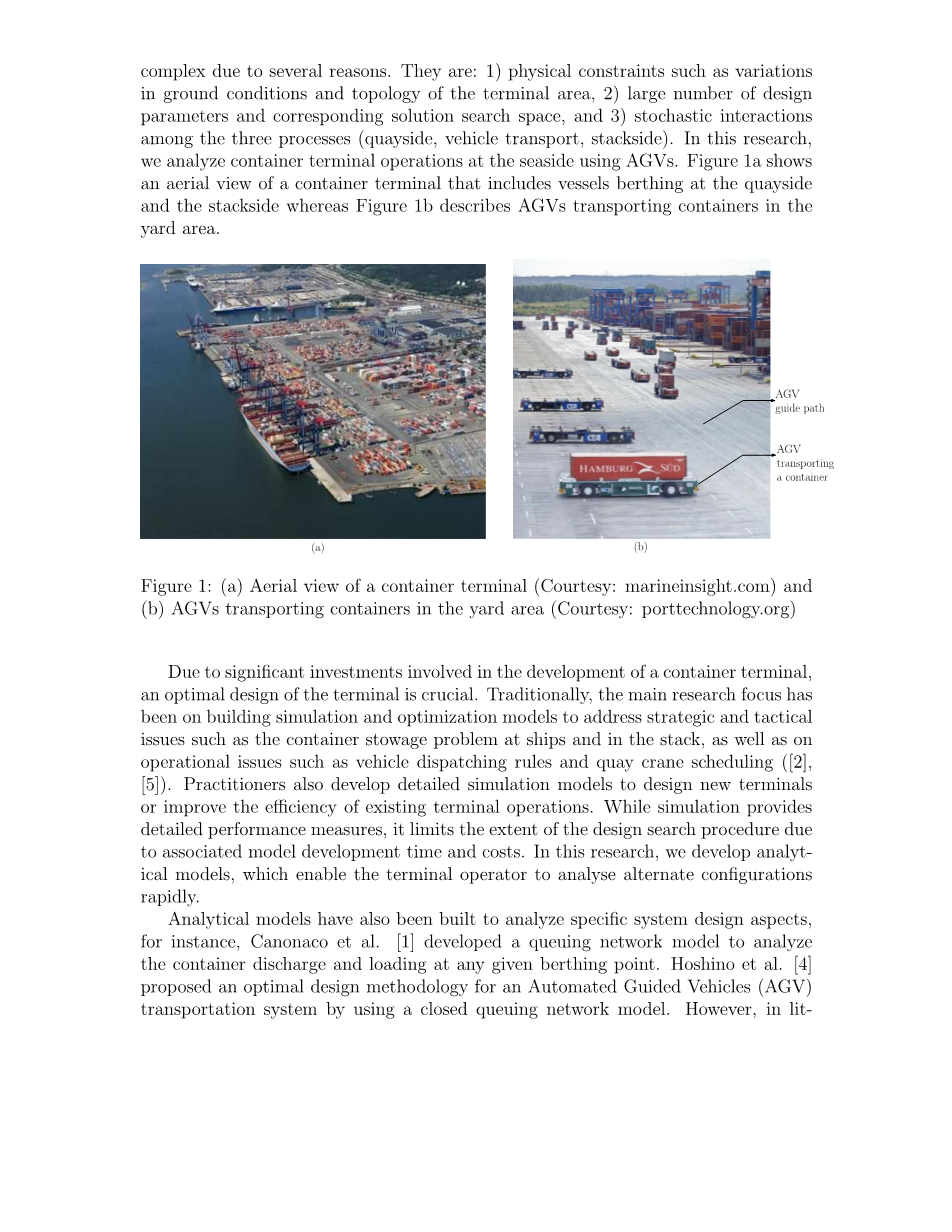

英语原文共 11 页,剩余内容已隐藏,支付完成后下载完整资料
Georgia Southern University
Digital Commons@Georgia Southern
12th IMHRC Proceedings (Gardanne, France –
2012)
2012
Progress in Material Handling Research
Optimal Design of Container Terminal Layout
Debjit Roy
Indian Institute of Management, Ahmedabad, debjit@iima.ac.in
Renacute;e de Koster
Rotterdam School of Management, Erasmus University Rotterdam, rkoster@rsm.nl
Follow this and additional works at: https://digitalcommons.georgiasouthern.edu/pmhr_2012
Part of the Industrial Engineering Commons, Operational Research Commons, and the Operations and Supply Chain Management Commons
Recommended Citation
Roy, Debjit and de Koster, Renacute;e, 'Optimal Design of Container Terminal Layout' (2012). 12th IMHRC Proceedings (Gardanne, France – 2012). 21.
https://digitalcommons.georgiasouthern.edu/pmhr_2012/21
This research paper is brought to you for free and open access by the Progress in Material Handling Research at Digital Commons@Georgia Southern. It has been accepted for inclusion in 12th IMHRC Proceedings (Gardanne, France – 2012) by an authorized administrator of Digital Commons@Georgia Southern. For more information, please contact digitalcommons@georgiasouthern.edu.
OPTIMAL DESIGN OF
CONTAINER TERMINAL LAYOUT
Debjit Roy
Indian Institute of Management Ahmedabad
Gujarat, India
Renacute; de Koster
Rotterdam School of Management, Erasmus University
Rotterdam, The Netherlands
Abstract
Due to rapid growth in foreign trade using sea vessels, there is a growing focus in improving the infrastructure and operational efficien-cies at the container terminals. Particularly, the operational respon-siveness of loading and unloading of containers, affects the vessel idle times and profitability of the shipping liners. In this research, we deter-mine optimal stack layout design, which minimizes the container unload times using Automated Guided Vehicles (AGVs). To analyze alternate stack layout designs, we develop integrated queuing network models that capture the stochastic interactions among the container terminal processes (quayside, vehicle transport, and stackside), and provides re-alistic estimates of expected container unload throughput times.
- Background and Motivation
Due to growth in international trade and better accessibility to the major seaports via deep-sea vessels, containerization has become the preferred mode for maritime ship-ping and inland transportation. Between 1990 and 2008, container traffic has grown from 28.7 million TEU to 152.0 million TEU, an increase of about 430% ([3]). Cur-rently, several new deep-sea as well as inland container terminals are being designed across continents. Several of the larger ones will be automated.
The design of the container terminal includes strategic design choices such as the terminal layout at the stackside, choice of equipment for handling containers at the seaside and landside, and type of vehicles for container transport between seaside and the landside. However, the process to arrive at an optimal design is extremely
complex due to several reasons. They are: 1) physical constraints such as variations in ground conditions and topology of the terminal area, 2) large number of design parameters and corresponding solution search space, and 3) stochastic interactions among the three processes (quayside, vehicle transport, stackside). In this research, we analyze container terminal operations at the seaside using AGVs. Figure 1a shows an aerial view of a container terminal that includes vessels berthing at the quayside and the stackside whereas Figure 1b describes AGVs transporting containers in the yard area.
AGV
guide path
AGV
transporting
a container
(a) (b)
Figure 1: (a) Aerial view of a container terminal (Courtesy: marineinsight.com) and
(b) AGVs transporting containers in the yard area (Courtesy: porttechnology.org)
Due to significant investments involved in the development of a container terminal, an optimal design of the terminal is crucial. Traditionally, the main research focus has been on building simulation and optimization models to address strategic and tactical issues such as the container stowage problem at ships and in the stack, as well as on operational issues such as vehicle dispatching rules and quay crane scheduling ([2], [5]). Practitioners also develop detailed simulation models to design new terminals or improve the efficiency of existing terminal operations. While simulation provides detailed performance measures, it limits the extent of the design search procedure due to associated model development time and costs. In this research, we develop analyt-ical models, which enable the terminal operator to analyse alternate configurations rapidly.
Analytical models have also been built to analyze specific system design aspects, for instance, Canonaco et al. [1] developed a queuing network model to analyze the container discharge and loading at any given berthing point. Hoshino et al. [4] proposed an optimal design methodology for an Automated Guided Vehicles (AGV) transportation system by using a closed queuing network model. However, in lit-
erature, integrated analytical models for analyzing the performance of loading and unloading operations by considering some of the stochastic inputs are scarce ([8], [7]). For instance, Vis et al. [9] assume deterministic AGV travel times while estimating the number of AGVs in a semi-automated container terminal.
New automated terminals typically adopt Automated Guided Vehicles (AGVs) for vehicle transport. AGVs do not have self-lifting capabilities and they need to be synchronized with the quay cranes at the quay side and with the stack cranes at the stackside to pick up
剩余内容已隐藏,支付完成后下载完整资料
资料编号:[239901],资料为PDF文档或Word文档,PDF文档可免费转换为Word


